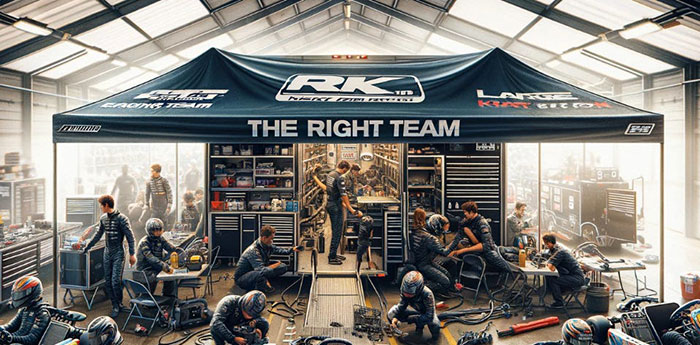An increasing number of drivers go karting via a formal race team. Instead of running their own show with their own equipment, they pay a third party to prepare and run their kart.
There are various pros and cons for running with a team, and various ways it can be done, from simply renting tent space on race day to full arrive-and-drive with all the perks.
It has spawned its own industry within the industry, especially for those contesting the bigger race meetings and series.
Terence Dove, publisher of On Racing Drivers, recently posted about choosing a team and getting the most from the experience.
“It’s not all obvious and most drivers fall into the same trap” he says.
His most recent newsletter, published below with permission, covers how to choose the right team (not necessarily the team that wins everything), how to avoid expectations that destroy your racing experience, plus how to start to take pole position in the team hierarchy.

by Terence Dove
When you’re shelling out money to join a racing team, it’s easy to fall into the trap of thinking:
“I’m paying, so they better deliver.”
Racing teams are racers first and foremost, trying to carve out a living. They’re not customer service reps waiting to cater to your every whim. This is where many go wrong, thinking that joining a team is a golden ticket to newfound speed and success. If that’s your line of thinking, you might be sorely disappointed and on the hunt for a new team sooner than you think.
What to look for in the right team for you
When you’re scouting for a kart racing team, chuck out any rose-tinted glasses and get realistic about what you’re stepping into. This isn’t a consumer market where you pay, sit back, and soak in the glory. It’s a gritty, relentless pursuit of racing victory, and the team you choose needs to reflect that hunger.
Here’s my advice on what to really look for:
- Ambition and Passion: You need a team that’s got fire in its belly. Look for a team owner still burning with ambition, passion, and a bit of unfinished business. They’ve got to be hungry for victory, whether it’s a championship they’ve missed out on recently or something they’ve yet to prove. This unfulfilled ambition is critical. You’re not just looking for a team; you’re looking for a crusade to join.
- Avoid the ‘Been There, Done That’ Teams: Steer clear of those teams that have been on a winning streak for what seems like forever. Why? Because for them, it’s just another year, another dollar. Their operation is slick, fine, but it’s driven more by the business of winning than the passion for racing. They trade on past glories and their reputable names, but there’s a catch – they are not as vulnerable or open to what you, as a driver, can offer them. They’ve seen it all, and frankly, they’re not as easily impressed or swayed.
- Look for Young, Hungry Teams: Your best bet is a team that’s either fairly new or venturing into something they haven’t tried before. Maybe they’re backing a new kart brand or stepping into a new championship. These teams don’t just need customers; they need drivers who bring something extra to the table. This is where you can make a real impact. They’re open, perhaps a bit vulnerable, and that’s exactly the kind of environment where you can thrive.
The types of drivers already in teams, and the type you need to be
There are a few types of driver in teams, some are the winning drivers who bring in new punters, some are quiet bill payers and some are a pain and make running a team a bit of a grind!
You need to understand these types, and create your own niche where you become the most favoured of all.
- The Hotshot: They’re often the team’s favourite, usually racing at a nominal fee or even for free. They’re attached to the team both emotionally and through their talent. These drivers are crucial for the team’s business and success. But remember, you can’t just walk in and claim this spot.
- Good Payers: These drivers are the financial backbone of the team. They are low-maintenance, meet their financial obligations without fuss, and don’t cause problems. They’re essential for the team’s financial stability but often lack the intensity that lights up the drive of the team members.
- Pain in the Arse Customer: These drivers are high-maintenance and have unrealistic expectations. They move around teams and often blame the team for their shortcomings. They expect miracles without adding any value themselves. This is not the driver type you want to emulate.
- The Driver You Should Be: You are paying but don’t adopt a customer mindset. You’re not there demanding services because of your payment; you aim to be a special part of the team. You should aim to become a “paying hotshot,” earning special treatment, discounts, and the best resources, not just because you demand them, but because you deserve them through your actions and contributions.
How to destroy your relationship with the team
If you watch a team manager defend their position with a disgruntled parent, or have a good old moan about drivers, you will see these observations come up.
If you want to make your team see you as the defacto number one, don’t do these!:
- Sit on a chair looking at your phone: This is especially critical if you’re not winning races. All the blame goes your way, because you’re not doing anything about it. Show you mean to win by being constantly engaged in finding ways to go faster with the team. Being physically present but mentally absent is a surefire way to underperform and be overlooked.
- Whine: There’s a thin line between being assertive and being a complainer. Your interaction with the team should be about seeking performance enhancements, not about lamenting what you don’t have. Ask the right questions – “How can I get faster?”, “What can we do to improve the engine?” – instead of pointing fingers. Remember, a racing driver is always after more, but how you ask for it makes all the difference. Teams respond to strength and positivity, not weakness and negativity.
- Expect Extras Just Because You Pay: Just because you’re a paying member of the team doesn’t entitle you to special treatment beyond the basics. Entering the team with an expectation of preferential treatment because of your financial contribution is a mindset that will lead to disappointment and potential resentment from the team. Your payment is for access and opportunity, not for guaranteed success.
- Put your feet up and wait for the results to come rolling in: Joining a team means your workload goes up, not down. It’s not a service you’re paying for; it’s an opportunity you’re given access to. This means more involvement, more communication, and more personal effort. You need to be proactive – visit the workshop, engage with the data guy, and actively seek better engine allocations. Your investment in the team should go beyond financial; it should extend to effort, time, and personal involvement.
What to do in a team to put yourself on pole position
- Transform Your Mindset: First and foremost, erase the notion of being just a customer from your mind. In the competitive arena of racing, you’re not just paying for a service; you’re paying for access to an opportunity. Long-term thinking is key.
- Foster Loyalty and Relationships: It’s about loyalty, not to the team per se, but to the people in it. You might change teams or racing classes, but maintaining good relationships is crucial. Whether through social media posts, bringing in new drivers, or through other means, ensure they feel your loyalty towards them as individuals. This makes them more likely to invest in your growth.
- Credit Where It’s Due: A clever tactic is to give credit to team members, even if you’re the one making the progress. If you shave off time in a corner, thank the data guy or acknowledge the boss’s earlier advice. It may seem like a small thing, but it creates a sense of shared success. They start to feel their efforts in working with you are paying off, which can be more gratifying than financial rewards.
- Be the Squeaky Wheel, Smartly: You need to be assertive but not whiny. Aggressive demands for improvement are fine, but they must be framed positively. Show passion without complaining. For instance, instead of whining about unfair engine allocations, demand a better engine with conviction. This approach can endear you to the team, reminding them of their own racing days or of drivers they respect.
- Performance and Engagement: Finally, and most importantly, you have to perform. But if you aren’t getting results now, show that you are hungry for learning, constantly engaged with the data and mechanics.
Show your dedication by working on the kart yourself, asking insightful questions, and being all over every aspect of your racing. This level of involvement and dedication will not only improve your skills but also earn you respect and support from your team.
Aim to match the team’s own hotshot driver
Every team has their hotshot – the driver who’s the center of attention, the one they’re banking on for wins and bringing in more drivers. But you can compete for that spot. It’s not just about being fast on the track, it’s about getting into their heads, becoming an integral part of the team’s success.
This is a mind game as much as it is about skill. Picture yourself taking on that role, being seen as equal or nearly equal to their current hotshot. It’s a delicate balance; you’ve got to be audacious enough to aim for it without stepping on toes.
Now, let’s say you’re not there yet, you’re still on a learning curve. That’s fine. What you need to do is double down on everything – all the strategies, tips, and techniques I talk about in my substack, in my book – apply them relentlessly. The aim is to get the team to notice you, not just as a driver, but as a person who’s genuinely committed to improving. When they start seeing your dedication, your drive to improve, that’s when you start getting under their skin, and they begin to invest in your success.
For instance, if you’re hitting the gym or taking on additional training like MMA, and the team suggests it, follow through. Let them see your progress and improvements. They start to believe they had a hand in it, and that’s when you’ve got them. This is about building a connection, a belief in your potential. When they see you leaving no stone unturned, especially following their advice, their admiration for you grows.
That’s when you start getting access to better resources – engines, carburettors. It’s about creating a situation where the team starts seeing you as a vital asset, possibly even more so than their current hotshot.
If the relationship with their hotshot isn’t rock-solid, you can start to shift the balance in your favour. Subtly, you start to become the standard to which they compare their hotshot. It’s a psychological game where you position yourself in a way that the flow of resources starts leaning towards you.
Become the team’s number one source of inspiration
Your goal is to lead the team in a way that doesn’t make it obvious that you’re leading. You let them feel that their efforts are paying off through you, their new protégé. It’s about making them believe in you, care about your success, and put in that extra effort for your wins. That’s the art of becoming an integral part of a team, where you transition from just another driver to someone the team rallies behind. This is how you make a mark and become indispensable – not just a driver, but a leader in your own right.
- written by Terence Dove, publisher of On Racing Drivers and EvenFlow Kart Driver Coaching


